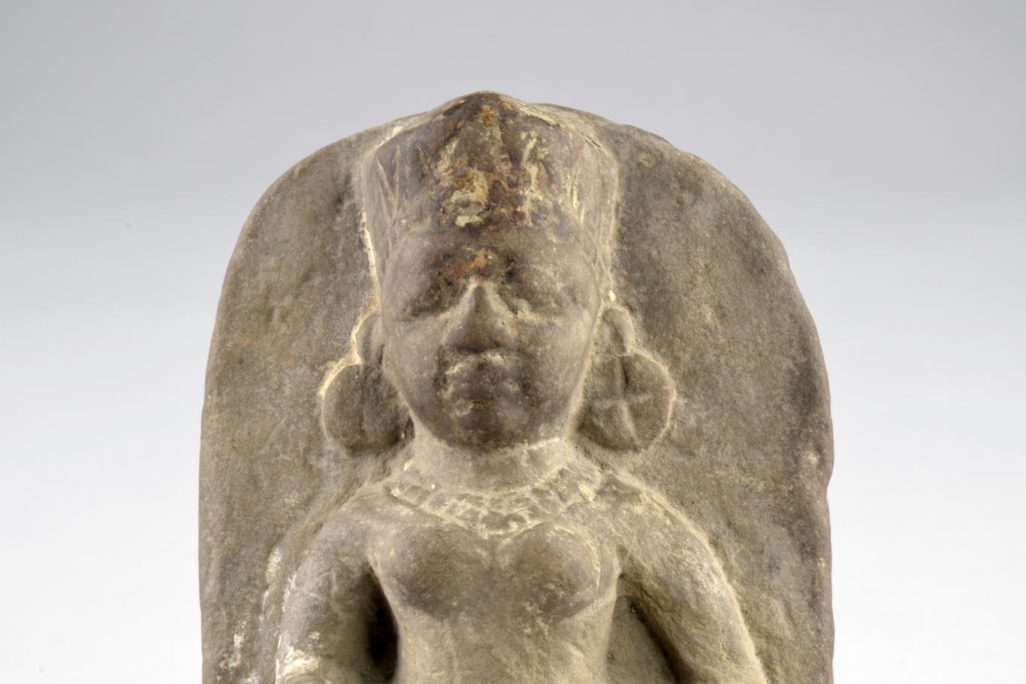Regina, Saskatchewan, Canada—Monday 15 November 2021: After 108 years, a stolen statue from the University of Regina’s collection at the MacKenzie Art Gallery, has been returned to a temple at the site where it was first taken. Identified as Hindu Goddess, Annapurna, the statue was taken over a century ago from its original location at a public shrine on the shore of the Ganges River in India at the direction of the Gallery’s namesake, Norman MacKenzie.
The unique repatriation process was initiated by artist Divya Mehra as an extension of her exhibition From India to Canada and Back to India (There is nothing I can possess which you cannot take away), which ran from 7 August 2020 – 2 January 2021 at the MacKenzie. Mehra encountered the statue on a site visit preparing for the exhibition and drew attention to it to the now Executive Director & CEO John G. Hampton. Noting the distinctive female qualities of the statue, which was previously miscatalogued as Hindu deity, Vishnu—Mehra reached out to Dr. Siddhartha V. Shah, Curator of South Asian Art at Peabody Essex Museum, who identified it as Annapurna. The piece’s misidentification was corrected in the fall of 2019.
The statue was part of the original 1936 bequest by Norman MacKenzie, the Gallery’s namesake to the University of Saskatchewan, Regina Campus (now the University of Regina). Noticing the statue while on a trip to India in 1913, a stranger had overheard MacKenzie’s desire to have the statue and stole it for him from its original location–a shrine at stone steps on the riverbank of the Ganges at Varanasi, India. When the current administration at University and the MacKenzie Art Gallery were alerted to the documentation which revealed the statue as an object of culture theft, both institutions committed to take taking appropriate action and repatriating the piece back to its rightful home. Commencing with a virtual repatriation ceremony via Zoom, the University of Regina’s Dr. Thomas Chase, Interim President and Vice-Chancellor, met with Mr. Ajay Bisaria, High Commissioner of India, to officially repatriate Annapurna—alongside Mehra, Hampton, and representatives from Global Affairs Canada, and Canada Border Services Agency also in attendance.
Union Culture Minister G. Kishan Reddy said: “This Murti [idol] will be taken in a procession to the Kashi Vishwanath temple where the pranaprathista will be performed, thereby reinstating the spiritual & divine grace of Maa Annapurna Devi. Blessed to have the Murti brought back to her rightful place.”
After sitting for decades in the collection at the Gallery, the statue is home today in Varanasi, and is to be installed in the newly renovated temple, Kashi Vishwanath, built on the shore of the Ganges River where she was taken. After a long-awaited, four-day ceremonial pilgrimage—arriving 14 November, Annapurna’s journey is now complete.
To honour the occasion, the MacKenzie Art Gallery will be exhibiting Divya Mehra’s 2020 sculpture There is nothing you can possess which I cannot take away (Not Vishnu: New ways of Darsána) which was produced to take the place of Annapurna. This sculpture—known as “Not Vishnu” for short—is a bag of sand purchased at a Hollywood prop store (rich in Indiana Jones memorabilia) and artificially aged by Mehra, and weighing the equivalent of the stolen stone sculpture. In 2020 this new artwork by Divya Mehra was accessioned into the MacKenzie’s Permanent Collection. The bag is displayed upon an altar produced as if for a film set, but when not on view it is stored in the space made vacant by the return of Annapurna—which still bears that sculpture’s outline.
More than just the physical object on display, Mehra’s work is an intervention into both the permanent collection and the narrative surrounding the founding of the MacKenzie Art Gallery. It draws attention to the widespread unethical practices that museums are built on, while urging them in a new direction. While Annapurna is no longer housed in the MacKenzie’s vault, her presence will forever be marked with this placeholder signaling a troubling history and a hopeful beacon for a new direction.

